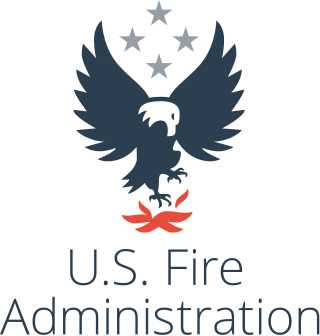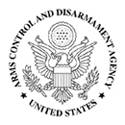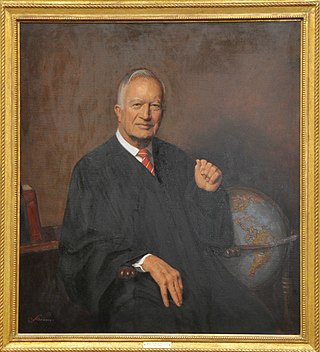Related Research Articles
The Nixon Doctrine was put forth during a press conference in Guam on July 25, 1969, by President of the United States Richard Nixon and later formalized in his speech on Vietnamization of the Vietnam War on November 3, 1969. According to Gregg Brazinsky, author of "Nation Building in South Korea: Koreans, Americans, and the Making of a Democracy", Nixon stated that "the United States would assist in the defense and developments of allies and friends", but would not "undertake all the defense of the free nations of the world." This doctrine meant that each ally nation was in charge of its own security in general, but the United States would act as a nuclear umbrella when requested. The Doctrine argued for the pursuit of peace through a partnership with American allies.

A firefighter is a first responder trained in firefighting, primarily to control and extinguish fires that threaten life and property, as well as to rescue persons from confinement or dangerous situations. Male firefighters are sometimes referred to as firemen.
The Comprehensive Employment and Training Act was a United States federal law enacted by the Congress, and signed into law by President Richard Nixon on December 28, 1973 to train workers and provide them with jobs in the public service. The bill was introduced as S. 1559, the Job Training and Community Services Act,
by Senator Jack Kemp(Republican of New York).

Fire safety is the set of practices intended to reduce destruction caused by fire. Fire safety measures include those that are intended to prevent the ignition of an uncontrolled fire and those that are used to limit the spread and impact of a fire.

The Psychotropic Substances Act of 1978 amended the Comprehensive Drug Abuse Prevention and Control Act of 1970 and Controlled Substances Act to ensure compliance with the Convention on Psychotropic Substances. 21 U.S.C. § 801a notes, "It is the intent of the Congress that the amendments made by this Act, together with existing law, will enable the United States to meet all of its obligations under the Convention and that no further legislation will be necessary for that purpose." The Psychotropic Substances Act created mechanisms by which the U.S. Government would add substances to the Schedules of controlled substances as required by the Convention. It also established a framework for exercising the U.S.'s rights to influence drug scheduling at the international level. The Secretary of Health and Human Services was given the power to make scheduling recommendations that would be binding on the U.S. representative in discussions and negotiations related to drug scheduling proposals before the Commission on Narcotic Drugs.

The United States Fire Administration (USFA) is a division of the Federal Emergency Management Agency (FEMA) located in Frederick County, Maryland, near Emmitsburg. Per the official website, "the mission of the U.S. Fire Administration is to support and strengthen fire and emergency medical services (EMS) and stakeholders to prepare for, prevent, mitigate and respond to all hazards".

David Lawrence was an American conservative newspaperman.

The U.S. Arms Control and Disarmament Agency (ACDA) was an independent agency of the United States government that existed from 1961 to 1999. Its mission was to strengthen United States national security by "formulating, advocating, negotiating, implementing and verifying effective arms control, nonproliferation, and disarmament policies, strategies, and agreements."

The Case–Church Amendment was legislation attached to a bill funding the U.S. State Department. It was approved by the U.S. Congress in June 1973 and prohibited further U.S. military activity in Vietnam, Laos and Cambodia unless the president secured Congressional approval in advance. This ended direct U.S. military involvement in the Vietnam War, although the U.S. continued to provide military equipment and economic support to the South Vietnamese government. It is named for its principal co-sponsors, Senators Clifford P. Case (R-NJ) and Frank Church (D-ID). The Amendment was defeated 48–42 in the U.S. Senate in August 1972, but revived after the 1972 election. It was reintroduced on January 26, 1973 and approved by the Senate Foreign Relations Committee on May 13. When it became apparent that the Amendment would pass, President Richard Nixon and Secretary of State Henry Kissinger, lobbied frantically to have the deadline extended. However, under pressure from the extreme scrutiny of Watergate, Republicans relented on support for South Vietnam and the amendment passed the United States Congress in June 1973 by a margin of 325–86 in the House, 73–16 in the Senate. Both of these margins for the amendment's passage were greater than the two-thirds majority required to override a presidential veto, and Nixon signed it on July 1, 1973. Although U.S. forces had been withdrawn from South Vietnam in March 1973 pursuant to the Paris Peace Accords, air support and monetary support for Cambodia and Laos continued until August 15, 1973, the deadline set by the Amendment.
Fire-safe cigarettes, abbreviated "FSC", also known as lower ignition propensity (LIP), reduced fire risk (RFR), self-extinguishing, fire-safe or reduced ignition propensity (RIP) cigarettes, are cigarettes that are designed to extinguish more quickly than standard cigarettes if ignored, with the intention of preventing accidental fires. In the United States, "FSC" above the barcode signifies that the cigarettes sold are fire standards compliant (FSC).

Malcolm Richard Wilkey was a United States circuit judge of the United States Court of Appeals for the District of Columbia Circuit and United States Ambassador to Uruguay.
The National Fire Academy (NFA) is one of two schools in the United States operated by the Federal Emergency Management Agency (FEMA) at the National Emergency Training Center (NETC) in Emmitsburg, Maryland. Operated and governed by the United States Fire Administration (USFA) as part of the U.S. Department of Homeland Security (DHS), the NFA is the country’s preeminent federal fire training and education institution. The original purpose of the NFA as detailed in a 1973 report to Congress was to "function as the core of the Nation's efforts in fire service education—feeding out model programs, curricula, and information..."
National Commission for the Observance of World Population Year 1974 - the United Nations observed 1974 as "World Population Year". President Richard Nixon established the National Commission to aid U.S. participation in this United Nations observance. Neither the Commission nor any of its members participated in the August 1975 international conference held in Bucharest, Romania.

The Education Amendments of 1972, also sometimes known as the Higher Education Amendments of 1972, were U.S. legislation enacted on June 23, 1972. It is best known for its Title IX, which prohibited discrimination on the basis of sex in educational institutions receiving federal aid. It also modified government programs providing financial aid to students by directing money directly to students without the participation of intermediary financial institutions.

The Federal Fire Prevention and Control Act of 1974 was created in response to the 1973 National Commission on Fire Prevention and Control report, America Burning. The report's authors estimated fires caused 12,000 deaths, 300,000 serious injuries and $11.4 billion in property damage annually in the United States, asserting that "the richest and most technologically advanced nation in the world leads all the major industrialized countries in per capita deaths and property loss from fire." The report proposed that a federal agency be established to help combat the growing problem of fatal fires happening throughout the country. The S. 1769 legislation was passed by the 93rd Congressional session and enacted by the 38th President of the United States Gerald Ford on October 29, 1974.
National Stroke Awareness Month is observed in the United States annually during the month of May. National Stroke Awareness Month was created to promote public awareness and reduce the incidence of stroke in the United States.

Aviation Drug-Trafficking Control Act of 1984 is a United States Federal law amending the Federal Aviation Act of 1958. The statutory law authorized criminal penalties for the unlawful aerial transportation of controlled substances. The Act of Congress mandated the revocation of aircraft registrations and airman certificates by the Federal Aviation Administration whereas an aircraft aviator knowingly engages in the transit of illicitly used drugs. The Act established authority and a statute of limitations for the reissuance of airman certificates by the United States Secretary of Transportation.
The presidency of Richard Nixon began on January 20, 1969, when Richard Nixon was inaugurated as the 37th president of the United States, and ended on August 9, 1974, when, in the face of almost certain impeachment and removal from office, he resigned the presidency.
References
- ↑ Ahrens, Marty. "America Burning 1973–2013 Work in Progress". National Fire Protection Association. Retrieved 3 July 2013.
- ↑ Fire Retardant Chemicals Association (1998). Fire Safety and Technology : Turmoil, Progress, Opportunities 1973-1998-2000+. Lancaster, Pennsylvania: The Association. p. 77. ISBN 1566767032.
- 1 2 Porter, Warren American Academy of Orthopaedic. Preplanning for EMS (1st ed.). Sudbury, Mass.: Jones and Bartlett Publishers. ISBN 9781449611118.
- ↑ Lo, S.M.; Richard K.K. Yuen (1999). "Views of building professional on the implementation aspects of fire safety engineering approach in building design – a preliminary study". International Journal on Engineering Performance-Based Fire Codes. 1 (3): 129–133.
- ↑ Peters, Gerhard; Woolley, John T. "Richard Nixon: "Statement on Receiving the First Report of the National Commission on Fire Prevention and Control.," March 31, 1972". The American Presidency Project. University of California - Santa Barbara.
- ↑ "America Burning : The Report of The National Commission on Fire Prevention and Control" (PDF). U.S. Fire Administration. Federal Emergency Management Agency. May 4, 1973. p. 192. OCLC 23601256.
- ↑ Peters, Gerhard; Woolley, John T. "Richard Nixon: "Statement About the Final Report of the National Commission on Fire Prevention and Control," July 12, 1973". The American Presidency Project. University of California - Santa Barbara.